Future-facing learning for student success: A Creative Campus Collaboration recap
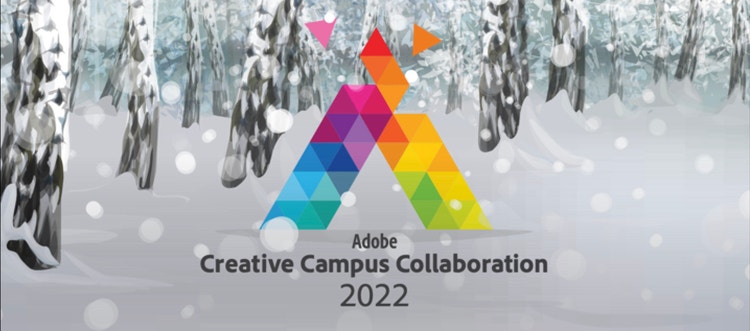
In February, Adobe hosted its latest Creative Campus Collaboration, focused on embracing key learnings in education over the past two years and implementing future-facing pedagogy, or curriculum with an increased use of technology to increase collaboration and student success. Creative Campus Collaboration events gather speakers and panelists from across the globe with academic leaders from colleges and universities to discuss the importance of integrating digital literacy and fluency across disciplines for all students and faculty.
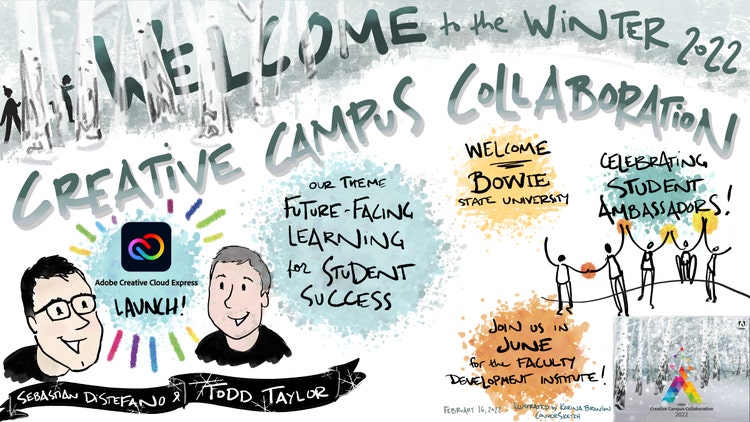
Hosted by Todd Taylor, Adobe Pedagogical Evangelist, Eliason Distinguished Professor of English, University of North Carolina Chapel Hill, the event detailed:
- How digital literacy can increase engagement for both faculty and students
- How digital literacy can improve student outcomes and develop the essential skills that employers value
- Successfully integrating digital literacy across the curriculum with innovative transformation
- How digital fluency can help to empower diverse voices and advocate for social justice and equity in education.
Building storytelling skills at the University of Arizona
The University of Arizona kicked off the day with a discussion emphasizing the importance of providing tools to foster digital literacy among both faculty and students. Speakers highlighted the institution’s embrace of digital learning, project-based curricula and new “digital maker spaces,” which have improved student engagement, facilitated inclusion and enabled greater creative skill development.
Melody Buckner, PhD, associate vice provost of Digital Learning and Online Initiatives, highlighted the Adobe Digital Learning Institute, which trains and incentivizes faculty to utilize Creative Cloud apps in curricula. She noted a university-wide course (SBS 350) grounded in digital tools-based projects that teaches students from any major essential storytelling skills using Adobe Creative Cloud.
“One of the things we are going to be talking about is Maus, a graphic book that was recently banned in Tennessee, and we are going to talk about how you would create a graphic novel using the Adobe products, as well as why books are banned,” Buckner said. “So this is not only a course about how to use Adobe, but we go into some really interesting topics around graphics and how graphics are used as well.”
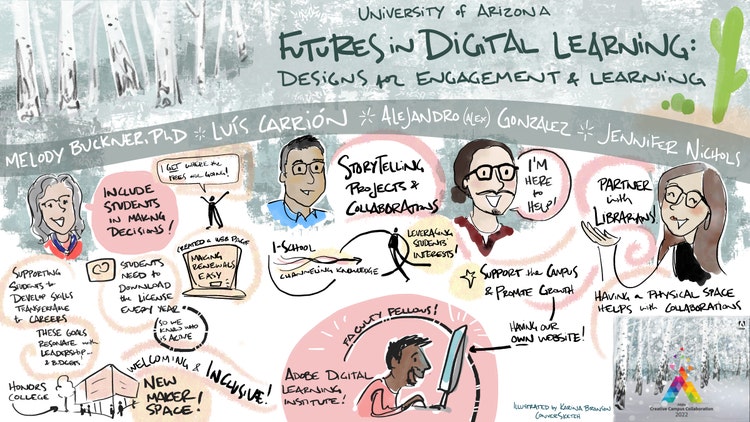
Jennifer Nichols, associate librarian and director of CATalyst Studios, shared that the digital maker spaces are open to the entire campus population, giving everyone access to various digital tools, from 3D printers and laser cutters to graphic design and audio/visual software — and most importantly, offering a peer-to-peer and active learning community.
“What we have to offer is a physical manifestation of what Adobe brings to our students. A place where people can see these things come to life and use these tools to create physical objects,” Nichols said. “Bringing all different disciplines together into a space where everyone belongs and no one is privileged over another has really created a really robust community.”
Indian River State College drives student success through digital transformation and career branding
As the one of first community colleges in Florida to provide Adobe Creative Cloud to every student, Indian River State College is delivering on its commitment to ensure their digital transformation journey does not leave any student behind. Education leaders from the institution stressed the importance of providing students with tools that meet them where they are in their digital literacy journey and teach them to build their personal brand to propel them forward post-graduation.
“We want to provide the tools at the ground level for our students. We want to empower our faculty to do the great things they do every day to be able to change the lives of our students,” said Timothy E. Moore, PhD, president of Indian River State College. “We want our students to be able to create a voice, create a brand, create an energy around them so that when they go out in the marketplace, they are able to do great things and achieve their God-given abilities.”
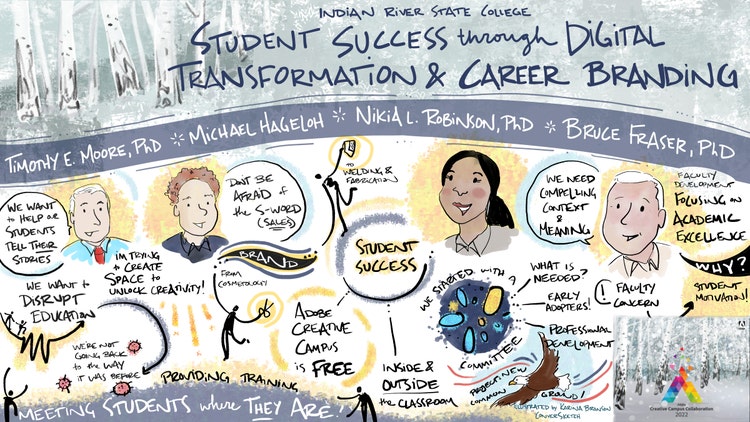
Fellow speakers rounded out the session by underscoring the institution’s commitment to preparing students for the modern workplace and continued success in their career journeys. Nikia L. Robinson, PhD, professor and department chair of computer information technology, and Bruce Fraser, PhD, professor of humanities and director of the Institute of Academic Excellence, described how they have implemented professional learning communities for faculty, who have in turn, developed project-based curriculum for their students.
“Every student has to understand that in the marketplace we live in, they are selling. They are selling for the next promotion, they are selling for a job,” said Michael Hageloh, executive vice president for Strategic Initiatives, interim vice president for Advancement. “And what’s behind selling? A brand. Everybody leaves Indian River State College ultimately with the ability to build a brand. Day one after they graduate, they are in business for themselves.”
Nurturing digital fluency and experiential learning opportunities at Weber State University
The past five years served as a critical period for colleges of all sizes to revamp their curricula as a means for enhancing student learning experiences and skill development. Education leaders and faculty from Weber State University shared a story of transformation, team work and tenacity to unlock new opportunities for students, and how they embarked on this journey after attending an Adobe Creative Campus Collaboration in 2016.
Brenda Kowalewski, associate provost for High Impact Educational Experiences and Faculty Excellence, Weber State, detailed how the transformation focused on improving three key areas: curricula, faculty development resources and on-campus learning spaces.
Jason Barrett-Fox, PhD, associate professor of English & director of composition, Weber State, explained how integrating Adobe Creative Cloud tools within university courses and composition program contributed to better student outcomes, from higher grades to increased retention. Students were more engaged with the curricula while simultaneously honing their creative skills and faculty deepened their knowledge of Creative Cloud through additional training resources offered. Project-based examples included utilizing InDesign to create an interactive magazine and leveraging Premiere Rush to make digital documentaries.
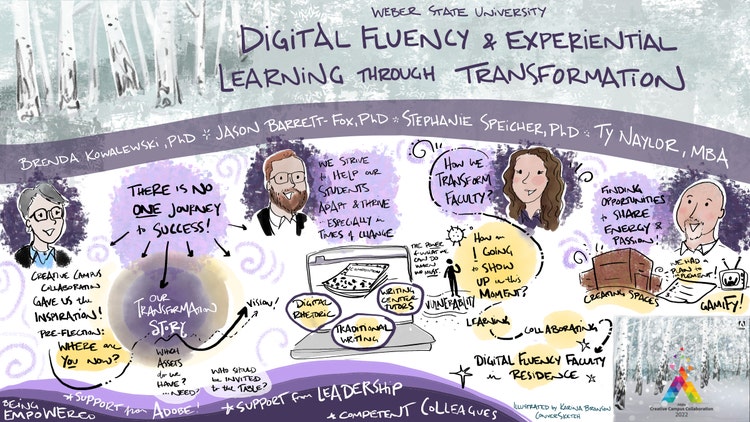
Ty Naylor, MBA, IT marketing and training manager, Weber State, detailed how academic leaders and faculty toured various experiential learning facilities at peer and aspirant universities to apply best practices and develop a blueprint to create innovative spaces on their own campus. Weber State developed a Digital District, which consists of designated teaching and learning spaces that are equipped with innovative technology, tools and support services to empower faculty and students to build a culture of digital fluency and creative exploration.
Kowalewski closed by emphasizing the success of collaborating and providing experiential learning opportunities for students across disciplines. She is excited for others to join in to see the measurable impact of digital transformation.
Civitas research shows demonstrable impact on student success with Adobe Creative Cloud
Adobe partnered with Civitas Learning, the University of Texas at San Antonio (UTSA), California State University Fullerton (CSUF) and East Tennessee State University (ETSU) on first-of-its kind research to measure the impact of integrating creative and digital literacy skills on student outcomes — and make it actionable for institutions.
Melissa Vito, PhD, vice provost for Academic Innovation, University of Texas San Antonio, and Angela Baldasare, PhD, principal and founder, Wonk Research + Consulting, discussed how the research quantified student success and revealed that students who use Creative Cloud in their classes demonstrated higher rates of A and B grades, higher grades overall, higher GPAs, and higher retention.
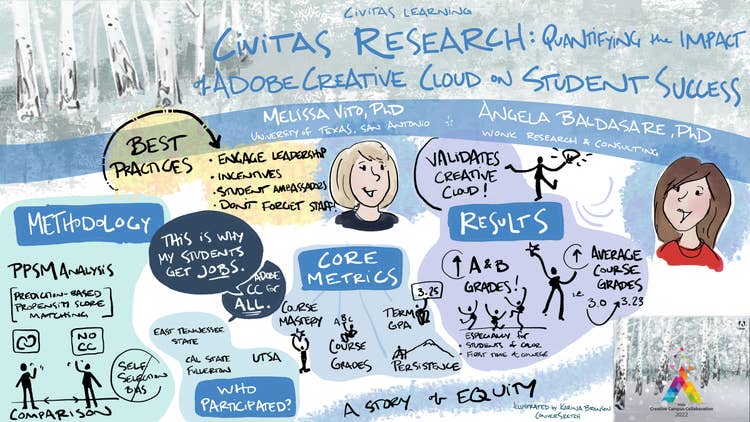
“It is very important that we focus on what our students learn and how they are positioned when they leave,” said Vito. “This research validated the impact of curricular use of Creative Cloud in courses that are not the ones we typically use in higher education. Schools that have Creative Cloud have a competitive advantage in what they offer to students.”
Vito outlined best practices for successfully adopting Adobe Creative Cloud in higher education, which included assigning a full-time staff member to support integration, empowering faculty to incorporate tools into curricula, developing campus resources (e.g. learning communities and student ambassador programs) to support use, and developing standardized assessment plans to measure impact.
Student panel: Building digital literacy sets students up for post-grad success
To wrap the event, Taylor moderated a panel of recent graduates to reflect on their digital storytelling journeys and how the skills they learned prepared them for success after college. Every panelist underscored how universities can improve the learning process by offering project-based assignments with a greater focus on digital media to make courses more engaging and impactful.
Valentina Arismendi, an alumna of University of North Carolina at Chapel Hill, shared that her journey as a digital storyteller began in Todd Taylor’s Multimodal Composition course. The skills she developed and honed eventually helped her secure a job at Adobe, where she is now creating content and learning resources for college students as a Classroom Curriculum Producer.
“Before I took Taylor’s class, I had a little bit of exposure to Adobe programs, but they were always used as tools of production, and for the first time in this class, they were used as tools of learning,” Arismendi said. “It wasn’t about what I was creating or how good it looked, it was more so the journey of creating and what I was learning along the way.”
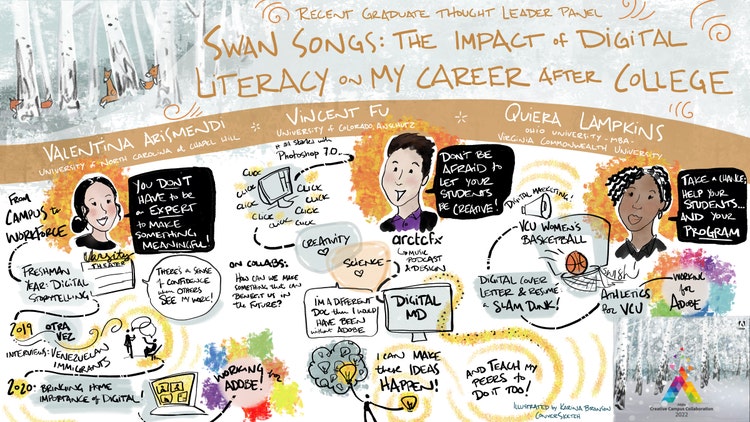
Vincent Fu, a graduate from the University of Utah currently enrolled at the University of Denver Medical School at Anschutz, reflected on the ways he has applied creativity into his STEM studies throughout his academic career. Fu uses his digital skills to create engaging presentations, infographics and guidebooks for class projects as well as in his work as an instructor. In addition to pursuing medicine, Fu shared how he was also accepted into business school recently, where he will be able to apply and integrate these valuable creative skills in yet another academic discipline.
“I think digital literacy is a way of thinking,” said Fu. “It doesn’t matter exactly what I’ve been making but the way that I’ve learned to think and apply that to everything I do, whether it’s medicine, in education or in design.”
The Creative Campus Collaboration events showcase diverse perspectives from academic leaders, faculty and recent graduates, sharing how digital tools can transform teaching and learning in any class and anywhere, across curriculum. By prioritizing digital literacy, higher education institutions are improving learning outcomes and ensuring students graduate with in-demand, transferrable skills they need to be successful throughout their professional journey.
To learn more about this series and building these competencies at your school, please contact your sales representative and visit our Digital Literacy resources page. Collaborate with more than 50 leading colleges and universities worldwide who make up the growing Adobe Creative Campus community.